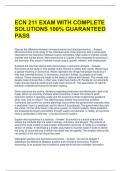ECN 211 EXAM WITH COMPLETE
SOLUTIONS 100% GUARANTEED
PASS
Discuss the difference between microeconomics and macroeconomics. - Answer-
Microeconomics is the study of the individual parts of the economy and is particularly
interested in the interaction between buyers and sellers. Main areas of interest include
markets and market prices. Macroeconomics is a study of the integrated functioning of
the economy. Key areas of interest include output, growth, inflation, and employment.
Evaluate the role that rational self-interest plays in economic analysis. - Answer-
Economics is the study of how people make choices to satisfy their wants. Wants have
a special meaning in economics. Wants represent the things that people would buy if
they had unlimited income. In economics, income is limited, so people must make
choices. These choices are made on the basis of rational self-interest. This means that
people make choices that, in their view, make them better off. People do not voluntarily
make choices that they believe will make them worse off. This assumption of rational
behavior underlies all economic decision making.
Since resources are scarce, decisions regarding production and distribution need to be
made. When an economy chooses what to produce, it takes into account which
economic system it operates under and the answers to three fundamental questions:
what, how, and for whom? Two differing ways answer this economics question.
Command and control (or central planning) occurs when the government oversees what
is produced, how it is produced, and for whom it is produced. The government also sets
the prices. On the other hand, in the price system (or market system), these questions
are answered by buyers and sellers through supply and demand. In reality, all countries
have a combination of the two - a mixed economic system.
Explain why economics is a science. - Answer- Economics is a social science that
utilizes the methods that are used in biology, chemistry, and physics. The science of
economics uses models to help explain and predict outcomes. A model is a simplified
version of reality. In developing a model, assumptions must be made in order to define
the array of circumstances in which the model may be applied. The simplest theory that
can predict is the one that should be used.
Distinguish positive and normative economics. - Answer- The end of Chapter 1
addresses the difference between positive and normative economics. Positive
economics is an analysis that is limited to statements that are verifiable. Normative
, economics can be identified by the use of the word should. Other words that provide a
flag that a normative statement, rather than a positive statement, is being made are
good, bad, best, desirable, undesirable, better, and worse.
In Chapter 2, you will study scarcity and the trade-offs that are made due to limited
resources.
Evaluate whether even affluent people face the problem of scarcity. - Answer- If you
stop and think about it, things such as time, clean air, and sleep are limited. The idea of
scarcity is fundamental to the study of economics. Scarcity exists in all societies and at
all income levels because human wants exceed what can be produced with the limited
resources and time that nature makes available. This, in turn, forces people to decide
what and how much to consume.
Understand why economics considers individuals' wants but not their needs. - Answer-
Needs are not objectively definable. Perhaps the best way to view a need is as an
absolute necessity required to stay alive, such as food or water. Wants refer to desired
goods and are unlimited. Therefore, in studying economics, an individual's wants are
taken into consideration, rather than needs.
Explain why the scarcity problem induces people to consider opportunity costs. -
Answer- Scarcity of resources requires choices be made. For example: Should you go
to the movie or study for your economics class for two hours? If you choose one, you
cannot also do the other due to the limited resource of time. When one choice is made,
another is given up. This brings you to opportunity cost, which is the highest valued,
next-best alternative that must be sacrificed for the choice that was made. In
economics, cost is always a forgone opportunity. Marginal benefit and marginal cost,
which look at the incremental cost (benefit) associated with one additional unit, help a
consumer to make choices.
The production possibilities curve (PPC) is a useful economic tool for understanding
trade-offs between wants. This tool helps to determine whether an economy is utilizing
all of its resources and is operating efficiently, and how overall growth may be
accomplished. An economy that operates inside the PPC is suffering from inefficiency. It
is not feasible for an economy to reach a point outside of the PPC since any point on
the PPC represents full efficiency.
Discuss why obtaining increasing increments of any particular good typically entails
giving up more and more units of other goods. - Answer- As choices are made, you
know that an opportunity cost applies to giving up the next best thing. This brings you to
the world of trade-offs. Whenever you engage in any activity by using any resource, you
are trading off the use of that resource for one or more alternative uses. For example,
instead of going to one movie, you spend the whole day at a film festival. In this case,
you give up more units of studying for your economic class. Therefore, the cost of fun at
the film festival is a lower economics grade.




